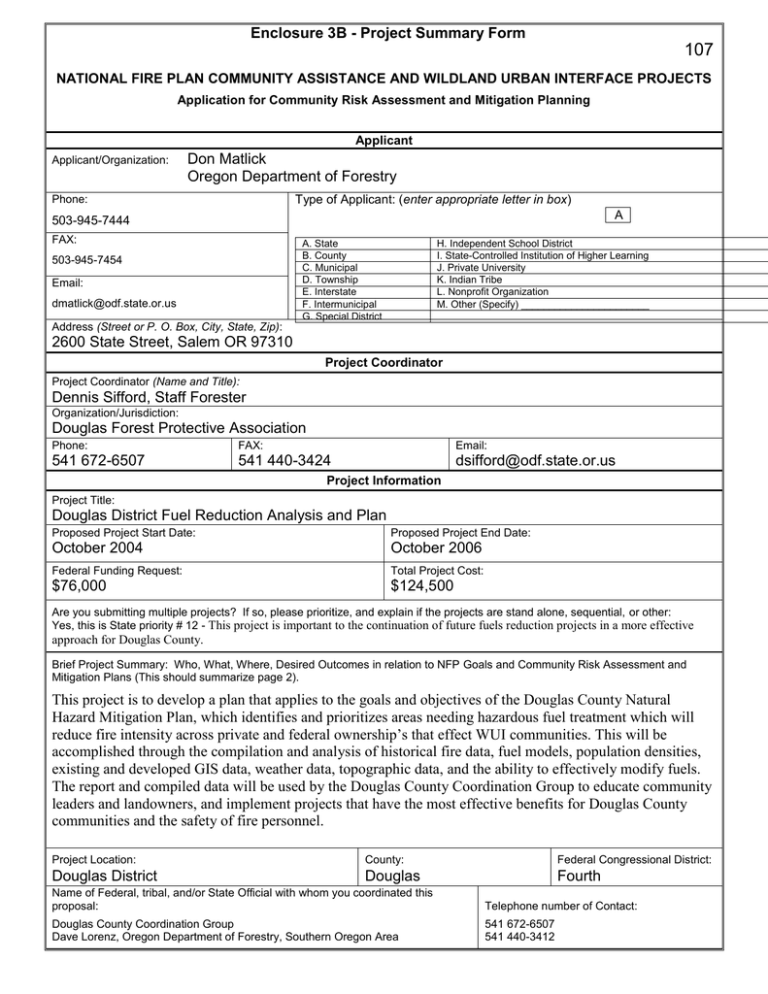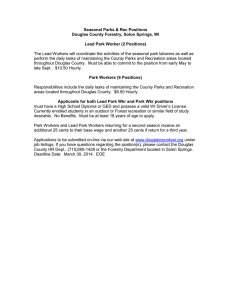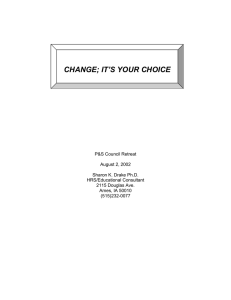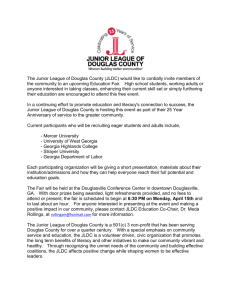107 Enclosure 3B - Project Summary Form Don Matlick
advertisement

Enclosure 3B - Project Summary Form 107 NATIONAL FIRE PLAN COMMUNITY ASSISTANCE AND WILDLAND URBAN INTERFACE PROJECTS Application for Community Risk Assessment and Mitigation Planning Applicant Applicant/Organization: Don Matlick Oregon Department of Forestry Phone: Type of Applicant: (enter appropriate letter in box) A 503-945-7444 FAX: A. State B. County C. Municipal D. Township Email: E. Interstate dmatlick@odf.state.or.us F. Intermunicipal G. Special District Address (Street or P. O. Box, City, State, Zip): Township 2600 State Street, Salem OR 97310 K. Indian Tribe H. Independent School District I. State-Controlled Institution of Higher Learning J. Private University K. Indian Tribe L. Nonprofit Organization M. Other (Specify) _______________________ 503-945-7454 Project Coordinator (Name and Title): Dennis Sifford, Staff Forester Organization/Jurisdiction: Project Coordinator E. Interstate L. Nonprofit Organization F. Intermunicipal M. Other (Specify) _______________________ Douglas Forest Protective Association G. Special District Phone: FAX: 541 672-6507 541 440-3424 Email: dsifford@odf.state.or.us Project Information Project Title: Douglas District Fuel Reduction Analysis and Plan Proposed Project Start Date: Proposed Project End Date: October 2004 October 2006 Federal Funding Request: Total Project Cost: $76,000 $124,500 Are you submitting multiple projects? If so, please prioritize, and explain if the projects are stand alone, sequential, or other: Yes, this is State priority # 12 - This project is important to the continuation of future fuels reduction projects in a more effective approach for Douglas County. Brief Project Summary: Who, What, Where, Desired Outcomes in relation to NFP Goals and Community Risk Assessment and Mitigation Plans (This should summarize page 2). This project is to develop a plan that applies to the goals and objectives of the Douglas County Natural Hazard Mitigation Plan, which identifies and prioritizes areas needing hazardous fuel treatment which will reduce fire intensity across private and federal ownership’s that effect WUI communities. This will be accomplished through the compilation and analysis of historical fire data, fuel models, population densities, existing and developed GIS data, weather data, topographic data, and the ability to effectively modify fuels. The report and compiled data will be used by the Douglas County Coordination Group to educate community leaders and landowners, and implement projects that have the most effective benefits for Douglas County communities and the safety of fire personnel. Project Location: County: Federal Congressional District: Douglas District Douglas Fourth Name of Federal, tribal, and/or State Official with whom you coordinated this proposal: Telephone number of Contact: Douglas County Coordination Group Dave Lorenz, Oregon Department of Forestry, Southern Oregon Area 541 672-6507 541 440-3412 Enclosure 3B (Page 1 of 3) - Project Narrative Description Applications for funding must include a narrative response that describes the proposal. Please do not submit responses longer than one page, single space, 12-pitch font. Describe project including, but not limited to: change fire behavior WHO are your collaborators - are they current or potential Address these through fuels reduction collaborators? items as increase community describe the relationship of this plan’s desired outcome to NFP Goals applicable: education and awareness and to any existing community fire protection plan. enhance fire protection project time frames and matching or contributed funds capability tools and/or skills needed to complete project desired outcome specific project location, geographic extent, and fire risk assessment methodology For this project, explain the level of cooperation, coordination or strategic planning, through a “Local Coordination Group.” If you haven’t worked with a local coordination group, why not? Change fire behavior: Fuels are considered hazardous if the quantity and arrangement is sufficient to contribute to undesired fire behavior. The management of fuels, specifically the reduction of hazardous fuel accumulations within and adjacent to communities, is the best opportunity to improve the chances for survivability of structures, and provide a safer environment for successful fire suppression efforts. With lower intensity fires, less fire-fighting resources are needed to suppress fires, therefore saving Douglas County communities and their watersheds from devastation and destruction. Increase education and awareness: A Firewise Workshop was conducted for Douglas County in March 2002 to educate community leaders and planners about the importance of planning Firewise communities. Outreach has been and will continue to be accomplished through onsite evaluations/assessments, local media (radio, newspaper, and television) coverage of the projects, community/townhall meetings, meetings with all our cooperators, informational signs, community events, association newsletters, and by word of mouth. Enhance fire protection capabilities: With the identification and prioritization of hazardous fuel areas within and adjacent to residences. Fuel reduction projects can be implemented to improve the conditions for fire suppression resources by reducing the risk of extreme fire behavior. Desired outcome: Through the evaluation of historical fire history, fuel conditions related to fire behavior, fire weather data, topography, population density, and the ability to modify the fuels, we will have an analysis and supporting GIS data that will specify fuel reduction/mitigation target areas for the communities and watersheds in Douglas County. Who are the collaborators: The Douglas County Coordination Group, which includes representatives from DFPA, BLM, USFS, Douglas County Fire Chief, Umpqua Watershed Council, and the Douglas County Soil and Water Conservation District. In addition, DFPA works closely with the Oregon Department of Forestry, Douglas County, Forest Landowner Associations, Douglas County Fire Chiefs Association, local community leaders and associations, homeowner groups, and forest consultants and contractors. The relationship to NFP and existing fire plans: The analysis will furnish specific information necessary to meet the goals and objectives for fuel reduction/mitigation in the Douglas County Natural Hazard Mitigation Plan and the Community Protection Strategy. The project outline lists all the NFP goals and guiding principles to be considered throughout the plans developmental process. Project time frames: The project time frame will be from October 2004 through October 2005. Tools and skills needed for the project: Aerial photos and most of the GIS data sets needed for the project already exist within collaborating partners. Computer hardware, software, and skilled personnel to conduct the analysis are readily available through local private forestry firm. Location and methodology: The analysis will be for the Douglas Forest Protection District’s Wildland Urban Interface areas, which will focus on the at risk communities and their watersheds, rural fire protection areas, and all private and federal lands within one (1) mile of the high-hazard areas. The analysis will identify and prioritize high-risk areas to be treated by using at a minimum the following factors: fuel model or natural vegetative fuels, historical fire history, population density, fire weather data, slope and aspect, ability to effectively modify fuels, fire protection services, and will address how fuel modification will change fire behavior. Enclosure 3B (Page 2 of 3) - Project Evaluation Criteria Applications for funding, must include narrative responses that address the following four criteria. Be sure you address every one briefly, yet thoroughly. Limit your responses to the area provided. 1. Planning for Action (40 points) A. Describe your desired plan outcome and how the outcome will be measured. B. How will the plan address : Fire behavior changes through fuels reduction Community education and awareness Enhanced suppression capability C. How will the completed plan be implemented, and by whom? OR How does this plan enhance or complete previous fire planning by the community? D. How will the plan address landowner responsibility for implementation of this plan? E. Describe your ability to complete project in one year of receipt of funds Response: A. Through the analysis and supporting GIS data, specific fuel reduction/mitigation target areas will be identified and prioritized so that our efforts can be more focused, and the projects will be the most costeffective. B. The analysis will identify and prioritize the areas where fuel reduction will moderate fire behavior. Fuels are considered hazardous if the quantity and arrangement is sufficient to contribute to undesired fire behavior. The management of fuels, specifically the reduction of hazardous fuel accumulations within and adjacent to communities, is the best opportunity to improve the chances for survivability of structures, and provide a safer environment for successful fire suppression efforts. With lower intensity fires, less firefighting resources are needed to suppress fires. Education will be through cooperator and interagency meetings, all forms of media, on-site visits, and by word of mouth. C. DFPA will monitor the development of the analysis, share the complete project with the Douglas County Coordination Group, and will utilize it to implement future fuel reduction work. The analysis will contribute significantly to the goal and objectives of fuel reduction Natural Hazard Mitigation Plan. D. Project landowners will continue to be responsible for the continued maintenance of the project site. E. We have collaborated with a local private forestry firm with the equipment, knowledge and skills to conduct the analysis within 1 year. 2. Enhancing Community Collaboration and Local Capacity. (30 points ) A. Describe your strategy for collaboration to develop this plan across multiple ownerships. B. Identify the interested partners and members of the community who are involved in this project, and the level of their involvement. C. How will this project enhance local community collaboration and local capacity for cooperative action? D. Describe skills or experience the community will gain through development of this plan. Response: A. This analysis will be used to identify and prioritize hazardous fuel areas that will need to be treated within 1 mile of Wildland Interface areas within Douglas District. The final analysis and supporting GIS data will be shared with all our interagency partners and stakeholders. We will encourage participation for joint fuel mitigation projects on adjoining ownership. B. Local fire districts and the Oregon State Fire Marshall’s (OSFM) office will supply historical fire data, Oregon Department of Forestry and DFPA will supply historical fire data and most of the GIS data, BLM and USFS will supply historical fire data and other GIS data, a local private forestry firm will compile, develop, and analyze the data, and publish the report. C. This project will identify hazardous fuel areas spanning private and federal ownerships, that will be presented to the stakeholders by the Douglas County Coordination Group. Which will encourage the development of cooperative plans for joint fuel reduction projects. D. This project will provide the missing information to accomplish the hazardous fuel reduction goals and action items outlined in the Douglas County Natural Hazard Mitigation Plan. Enclosure 3B (Page 3 of 3) - Project Evaluation Criteria 3. Expanding Community Participation. (30 Points) A. B. C. D. E. Explain the level of cooperation, coordination and/or involvement of the Local Coordination Group. List the cooperators/members (in a broad way) of the local area coordination group. Describe your strategy for leveraging funding. Who are the partners and what is their commitment to the plan’s completion, including any existing or proposed cost-share agreements and their status. Describe the extent of local support or opposition for the project. Describe your strategy for post-plan marketing and collaboration for the successful implementation of the next steps described in the plan. To what extent will this project be offered to serve as a model for other communities in your sub-geographic area, state-wide area? Response: A. The Douglas County Coordination Group, which includes representatives from DFPA, BLM, USFS, Douglas County Fire Chief, Umpqua Watershed Council, and the Douglas County Soil and Water Conservation District, supports this project. The members meet to evaluate the opportunities for cooperative projects across ownerships. B. In relation to the WUI areas, the Roseburg BLM District has begun to identify hazardous fuel areas on their ownership. However, there has not been any specific work done for the private ownership. It is critical that this project be funded and undertaken, because of the checkerboard pattern of ownership within Douglas District of BLM and private industrial lands, as well as private lands interspersed among USFS ownership. The information compiled will provide support for DFPA, BLM, USFS, and corporate partners to leverage funding from multiple sources, i.e. other grant programs, and agency or corporate budgets, for fuel mitigation projects. C. Support for this project is very encouraging from cooperating partners, community leaders, private forest landowners, and our County Commissioners to the next door neighbor. This project is important to the continuation of future fuels reduction projects in a more effective approach. Our partners are looking to DFPA to take the lead and secure funding for this project. D. By completing an inventory of hazardous fuel areas in need of treatment that are specific to WUI communities. We will use the information to educate landowners and community leaders, and encourage them to participate in projects across ownership boundaries that will address life safety and resource protection. The information can be used by community leaders and local fire officials to enhance or amend Community Natural Hazard Mitigation Plans. In addition, the information will be used by the Douglas County Wildland Urban Interface Classification Committee to identify specific areas that meet the criteria established in Senate Bill – 360, Oregon Administrative Rule Chapter 629, Division 44 “Criteria for Determination of Wildfire Hazard Zones”. E. This project will be shared with all our local partners, and all geographic areas across the state and region through interagency networking meetings, and/or conferences to be used by others as a model for their jurisdictions. Enclosure 3C - Project Work Form Tasks Develop an agreement/contract with local forestry firm for the project. Time Frame October 2004 Responsible Party DFPA Grant Administrator Collect and compile existing data from October 2004 to February 2006 partners. Project contractor Create hazardous fuel layer for communities, and for all lands within 1 mile of WUI areas. February 2006 to July 2006 Project contractor Analysis information and publish information. July 2006 to September 2006 Project contractor Review Report and GIS Data October 2006 to November 2006 Douglas County Coordination Group Identify specific target treatment areas, educate landowners, encourage collaborative projects, and secure funding. October 2005 to October 2006 DFPA Project Coordinator, Douglas County Coordination Group, and DFPA Grant Administrator. Distribute copies of the report to Douglas County officials, community leaders, and fire department chiefs November 2006 DFPA Project Coordinator, Douglas County Coordination Group, and DFPA Grant Administrator. Enclosure 3D Project Budget Cost Category Description Federal Agency Applicant BLM/USFS OSFM/RFPD Total Personnel Subtotal 6,369 23,055 4,000 1,500 6,369 23,055 4,000 1,500 4,620 10,800 4,620 10,800 $34,924 Fringe Benefits Subtotal $15,420 Travel 2,175 Subtotal 2,175 $2,175 Equipment 435 Subtotal 435 $435 Supplies 435 Subtotal 435 $435 Contractual 63,000 Subtotal 63,000 $63,000 Other Subtotal Total Costs 2,011 6,100 2,011 6,100 $76,000 $43,000 $8,111 $4,000.00 $1,500.00 Project (Program) Income1 (using deductive alternative) 1 Program income is the gross revenue generated by a grant or cooperative agreement supported activity during the life of the grant. Program income can be made by recipients from fees charged for conference or workshop attendance, from rental fees earned from renting out real property or equipment acquired with grant or cooperative agreement funds, or from the sale of commodities or items developed under the grant or cooperative agreement. The use of Program Income during the project period may require prior approval by the granting agency. $124,500




